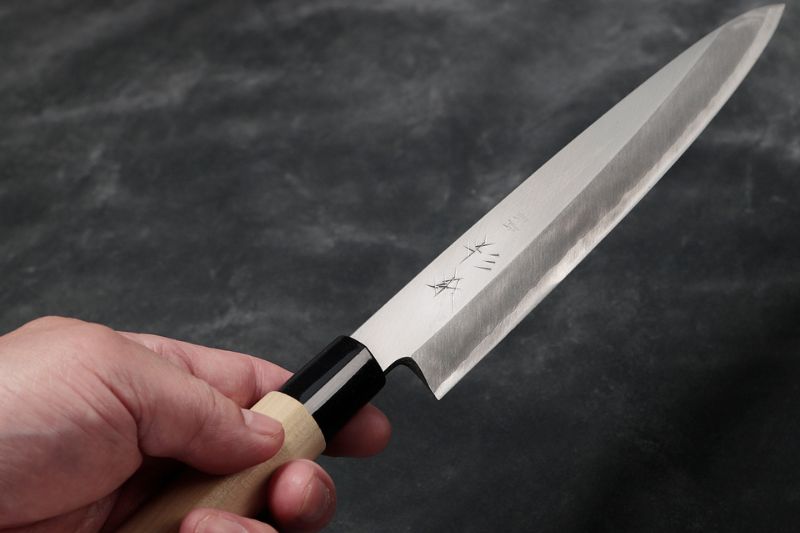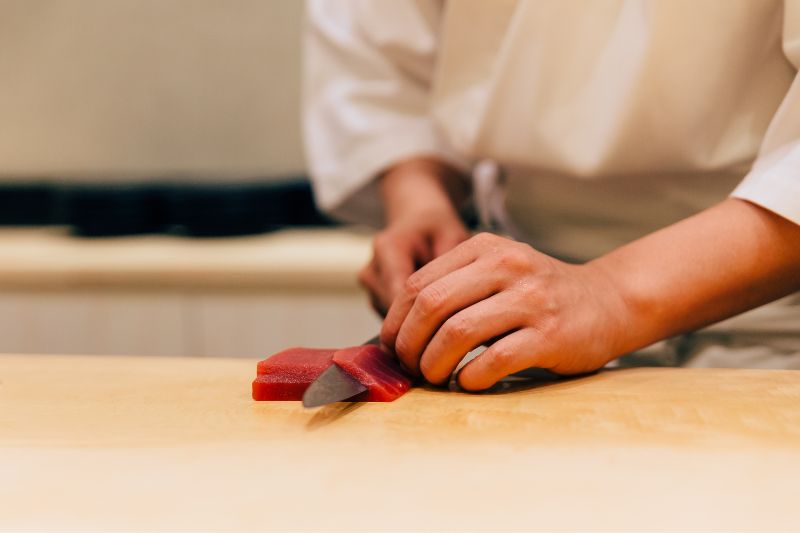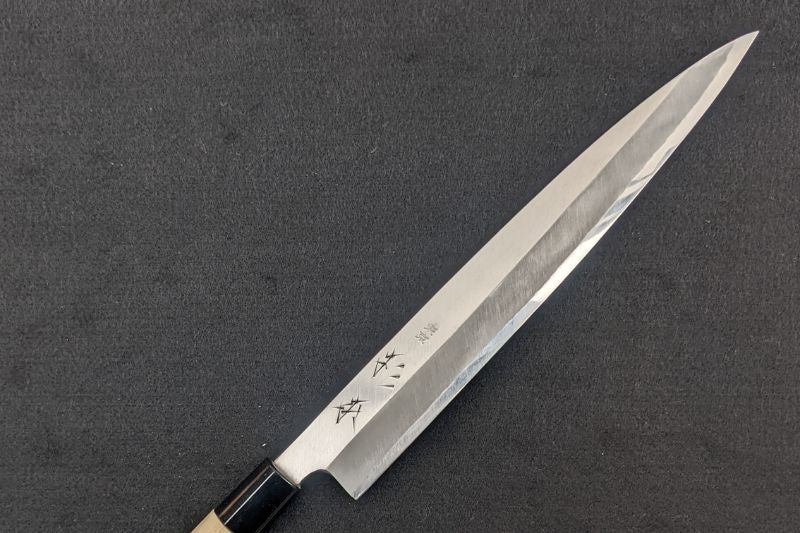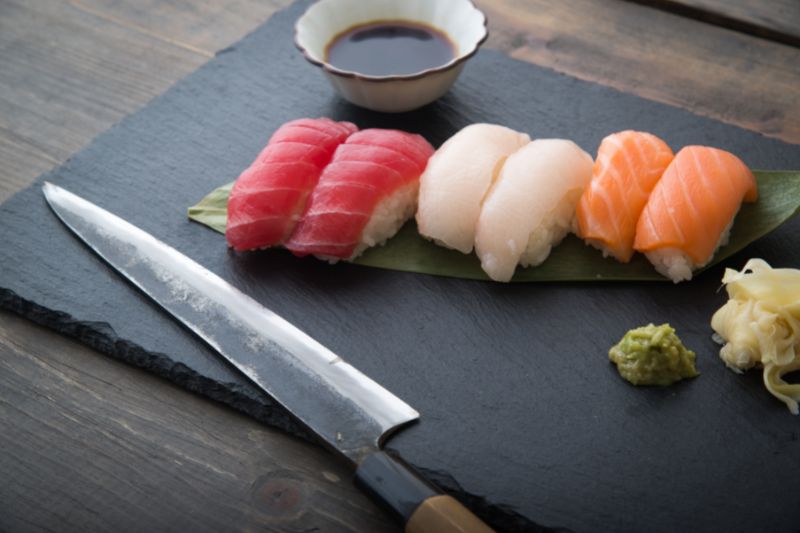The Yanagiba Knife
The Yanagiba (柳刃包丁) is a special knife with a particular use. Its primary purpose is creating perfect slices of raw fish that, when served on its own, is known as sashimi(刺身). This raw fish is sometimes placed on vinegared rice or rolled with rice and seaweed to form sushi. No doubt you have heard of (and eaten) one or both of these popular Japanese dishes before. If you're interested in learning more about sushi and sashimi and want to learn a few Yanagiba cutting styles, read on. And for those who aren't fa ns of seafood, don't worry; there are other ways this knife can be helpful to you.
Aspiring to Perfection: The Structure of This Article
For this article, I'm going to take you through some of the history of sushi, as this is the specialty of the Yanagiba. I'll then explain some of the features and techniques specific to this knife that you can use. By the end of this article, you'll know a lot more about the surprising origins of sushi and might even pick up a few tips on improving your culinary skills.

The History of the Yanagiba
In order to understand the history of the Yanagiba knife, one must also understand the origins of sushi. That’s because the Yanagiba is, above all, a sushi knife. So, let’s first explore how sushi came to be, and in turn, how it inspired the creation of the Yanagiba.
The Story of Sushi Begins Over a Thousand Years Ago During the Nara Period
The first forms of what we know today as sushi appeared during Japan's Nara period (奈良710-784 CE). It was, in fact, nothing like sushi. Instead, it was called narezushi(なれずし、熟れ鮨、馴れ鮨), a popular way at the time of preserving fish. First, they would place the fish into a barrel with rice, then put a heavy weight on top. It would then be left to ferment for months. Afterward, they would discard the rice and be left with a pungent fermented fish. Not precisely the super-fresh sushi we expect today.
Early Sushi Began to Get Fresher and Eventually Became a Convenient Street Food
Over hundreds of years, this early form of sushi began to change. The Japanese gradually shortened the length of time it took to produce narezushi. Then, namanare (なまなれ、生なれずし)appeared during the Muromachi period (室町1336-1573 CE). It was made the same way as narezushi but in weeks rather than months and then eaten with rice. Although semi-preserved, it still retained more of its fresh taste and eventually replaced narezushi.

In the Edo Period Came the First Forms of Modern Sushi
During the Edo period, a form of sushi close to what we eat today was invented. This early sushi was made with large portions of rice, almost like rice balls, topped with fish. Eventually, it was wrapped in 'packaging' for convenience, such as bamboo leaves.
Sometime During This Same Period The Yanagiba Also Appeared
Because sushi was slowly becoming a smaller and more refined dish, sushi makers began to require specific knives to achieve the delicate cuts they required. So, at some point during the Edo period the Yanagiba was created. And because its long, slender shape was so good for cutting beautiful slices, it quickly started to become a crucial tool for this new wave of cuisine.
At Last, During the Meiji Period(明治), Modern-Style Sushi Made Its First Appearance
In the 1800s, makizushi (巻きずしthe seaweed-wrapped sushi roll) was finally created. An explosion in the popularity of this delicious food cemented the place of the Yanagiba as a must-have sushi knife for experts and homecooks alike. Where other knives were replaced with multi-purpose wonders like the Gyuto and Bunka, the Yanagiba continued to endure because of its unique purpose and unsurpassed performance.
Today, the Yanagiba is Found Everywhere That Sushi is
The Yanagiba and a few knives similar to its design have become the primary tools of sushi chefs. Over time, the Yanagiba has even come to be a common knife for homecooks in Japan. And these days, as the popularity of sushi has become global, the Yanagiba is being used in kitchens across the world.
Features
Long Blade for Perfect Slices
The Yanagiba is designed to cut through fish in a single stroke to avoid damaging or tearing the fish. To achieve this, it has a very long blade, so it doesn't need to be sawn back and forth. Avoiding this movement helps to improve the presentation of food dramatically by limiting the damage to cells and stopping jagged cuts from forming.

A Pointed Tip for Filleting

One of the great things about a Yanagiba is that because it has a pointed tip, it can also be used for filleting fish small to medium-sized fish, so there’s no need to switch between knives. And, because of its slender blade you can even use it to cut the skin off fish too.
Surprisingly Light Weight

The Yanagiba may appear to be a heavy knife because of its length. However, because it is made so thin, it is very light. This design counteracts the size and makes it easier to maneuver. A good Yanagiba should be well-balanced and not too heavy at the point.
How to Use a Yanagiba
Slice in a Single Stroke With a Pull-Cut
A pull-cut is when you pull the knife towards yourself rather than cutting forward or rocking it on the board. This cut is the best way to preserve the texture of the fish or meat. Begin with the knife's heel on the fish, and slowly draw the blade back toward yourself, allowing the knife's weight to push down through the fish. If your knife is well-sharpened, it should easily pass through.
There Are Three Main Methods to Present Fish Using the Yanagiba
These simple pull-cutting methods will give you a variety of options in presenting fish and give you the ability to achieve the texture you want. Don’t be intimidated – ultimately these are just terms to help remember each style of cut. Try these out next time you are making sushi or sashimi.
- Hirazukuri (ひらづくり、平造り) is a verticle pull-cut used on salmon or tuna. It should produce a reasonably thick portion of roughly half an inch. This is by far the easiest method. Simply, do a pull-cut at a 90 degree angle.
- Usuzukuri(うすづくり、薄造り)is the same motion as the previous technique but a lot thinner and usually reserved for white fish, creating a thin, almost transparent slice. Don’t be discouraged if this is more difficult to do than it sounds. It takes practice to get thin, consistent slices.
- Sogizukuri(そぎ造り)is a pull-cut angled to make a thin, slightly wider slice of fish. Of the three, this is the most difficult and potentially dangerous method. With your free hand, hold under your fingers the piece of the fish you want to slice, and then pull-cut at a 40 degree angle. The knife should go through the fish that’s under your fingers. Ensure that you make a sufficiently thick slice of fish so that you don’t risk cutting your fingers.

Cut Slowly for Accuracy and Safety
I know you want to be as fast as the sushi masters, but please be careful! Because you will sometimes be holding the fish down with your free hand, using a Yanagiba can be dangerous, especially when doing an angled cut like sogizukuri. So it is best to take it slow, to begin with. Get used to the feel of the knife. Rushing won't make the food taste any better, and it will look much nicer if you take your time.
Get the Best Quality Fish You Can Find
You may find fish called 'sushi grade' or 'sashimi grade,' which is perfect for eating raw. In any case, you should look for the freshest fish possible and look up the health guidelines for eating raw fish in your country. If you aren't a hundred percent certain that the fish you have is appropriate for eating raw, then it is safest to avoid doing so.
Should I Buy a Yanagiba?
Not Appropriate for Complete Beginners
The only type of person I would caution against buying a Yanagiba is a beginner or someone looking for a multi-purpose knife. If you are one of these people, consider purchasing a Gyuto, Bunka, or even a Petty knife. Not only can the Yanagiba be dangerous for a beginner to use, but you also won't be able to use it for vegetable chopping.
A Sushi Lover’s Best Friend
However, If you are a sushi hobbyist, the Yanagiba will feel fantastic. It will bring you closer to professional-style sushi and sashimi than is possible with a standard chef's knife. The smooth ease with which the Yanagiba cuts perfect fish pieces will shock you. It will drastically improve your knife skills and the beauty of your dishes. Get a Deba and Nakiri to go along with it for a complete set.
But You Can Use It for a Lot More Than Just Fish
For generally experienced cooks, even if you prefer to eat something other than raw fish, the Yanagiba can be helpful. You can still use it for filleting and skinning fish before you cook it. Additionally, use it for cutting thin slices of beef or chicken for barbeques, sandwiches, or stir-fries. It even makes for a decent carving knife for roasts.
Click here to learn more about this Yanagiba KnifeGet Free Bonus Books

Sign up for free to the Japanese Knife Club to get advice and exclusive articles about how to choose Japanese Knives, and tips and tricks for using Japanese knives.
About the author
Kei Nishida
Author, CEO Dream of Japan
Certification: PMP, BS in Computer Science
Education: Western Washington University
Kei Nishida is a passionate advocate of Japanese craftsmanship, a writer, and the founder and CEO of Japanese Knife Co., Japanese Green Tea Co., and Japanese Coffee Co., all part of Dream of Japan.
His journey began with a mission to introduce the world to the exquisite flavors of Japanese green tea. Through Japanese Green Tea Co., he pioneered the import of premium tea grown in nutrient-rich sugarcane soil, earning multiple Global Tea Champion awards. He then expanded into the world of coffee, launching Japanese Coffee Co., the first company to bring Sumiyaki charcoal-roasted coffee to a global audience.
With a deep appreciation for Japanese artistry and tradition, Kei turned his attention to one of Japan’s most revered crafts: bladesmithing. Through Japanese Knife Co., he made handcrafted katana-style knives, created by a renowned katana maker, available outside Japan for the first time. These exceptional knives embody centuries of samurai sword-making expertise, blending tradition with modern functionality for chefs and collectors alike.
Kei’s journey continues as he uncovers and shares Japan’s hidden treasures—one sip, one blade, and one legacy at a time.


























